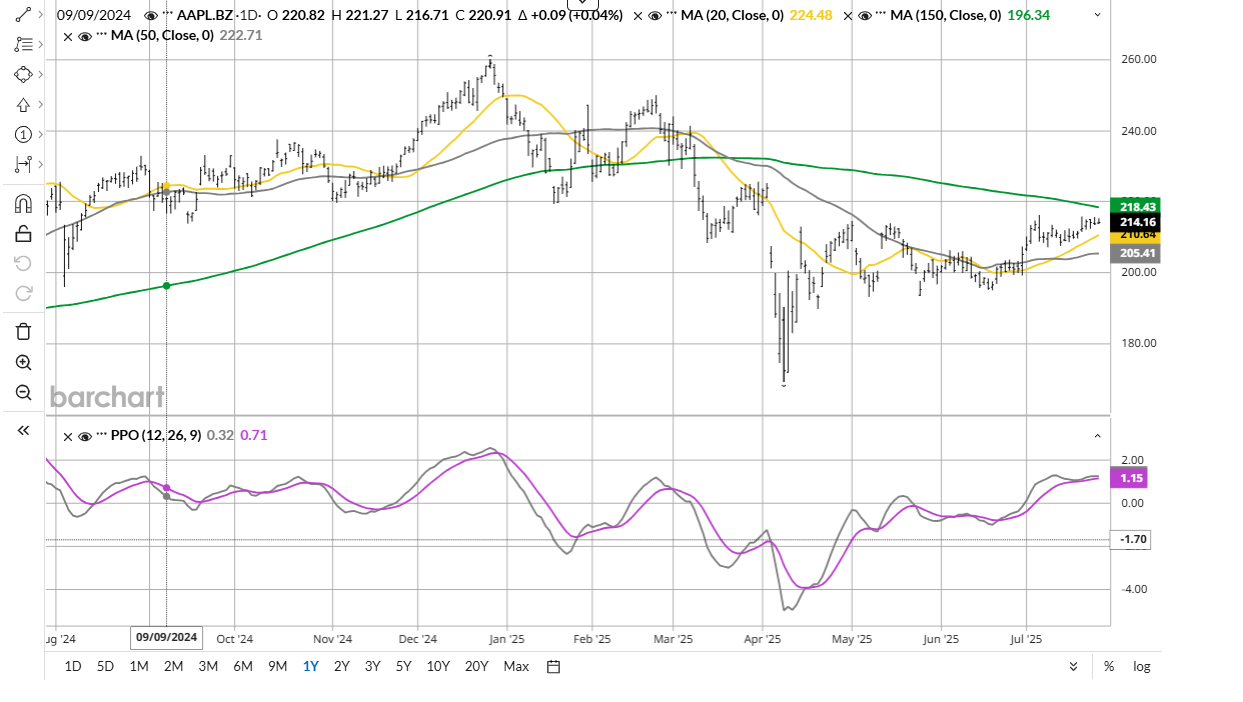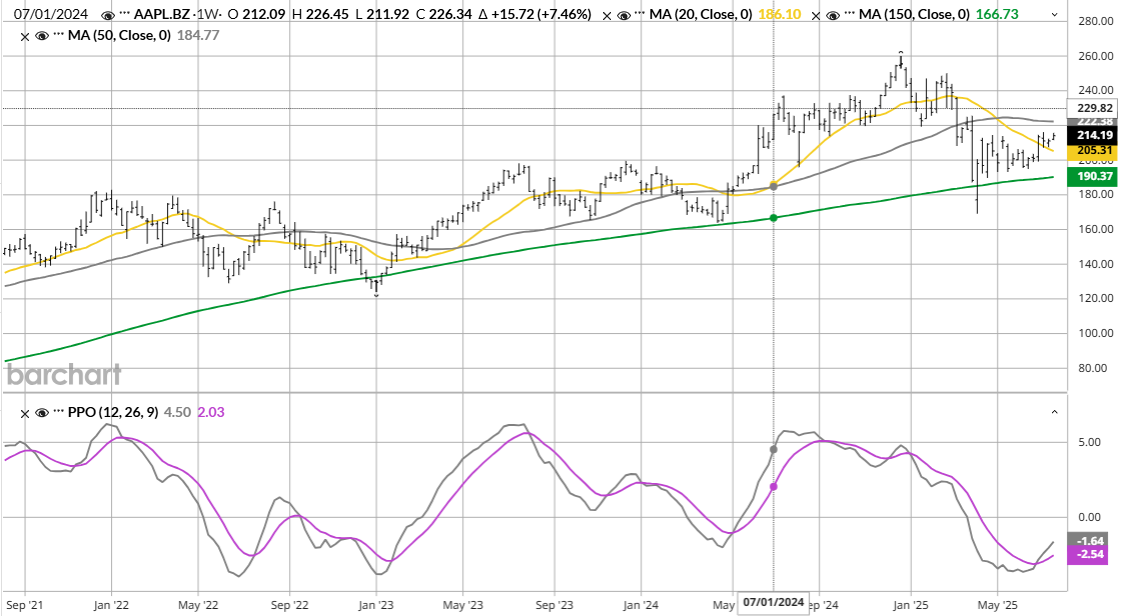/Apple%20logo%20on%20store%20front%20by%20frantic00%20via%20iStock.jpg)
Apple (AAPL) is certainly a familiar name for investors. But it has been acting strangely this year, especially for a stock that was the first to cross the $3 trillion market cap level. As we see here, it is still above that perch.

However, questions about the firm’s ability to continue to deserve its lofty multiple, currently around 30x trailing earnings, and its ability to compete in the artificial intelligence business have dogged AAPL this year. The stock is off more than 14% year to date, well behind the broader market.
That makes next week’s earnings report even more of an “event” than usual. So if you look at investing first as an exercise in risk management, and not as a sport or a casino game, an option collar might be a way to get exposure to AAPL while reducing the risk associated with a post-earnings decline.
Show Me the Chart First!
That’s what I say to myself, as well as the folks I coach on using collars. Sure, you can technically collar any stock or ETF with a liquid options market. However, “throwing good money after bad” is not a great habit. So as a 40-year chartist, and one who has seen a ton of manic markets, I only want to move forward if the stock chart indicates to me that there’s a fighting chance the stock will go higher.
That said, we’re seeing again this earnings season that any company can be “taken out back and shot,” to use a phrase from old Western movies. So with AAPL, I look at the daily chart below with my eyes wide open.
I see a stock that is trying to mount a comeback. That 20-day moving average in yellow is trending well. But the PPO below is a bit choppy. And while many technicians wax poetic about this or that indicator, I’m a bit more visual, and less jargony.

The weekly chart below is more encouraging, and also less. What? Allow me to explain.
This is a market characterized by stocks that have been down on their luck suddenly surging in price. That makes traditional technicians happy, because it is positive momentum.
However, like a sprinter in a horse race, if the speed can’t be maintained long enough, the finish will not be as successful as the start. I see that risk with AAPL’s weekly chart here. The 20-week moving average is still in a downtrend, and the PPO just crossed up. That latter aspect of the chart is good, but when that occurs so far below zero, it is less reliable.

This all paints a picture for me of a stock that has a chance to move higher, but that an event like the forthcoming earnings report on Thursday, July 31 could easily blow that out of the water. But for those who like AAPL, collaring it can allow you to have your cake and eat it too.
Here’s one collar combination I zeroed in on. The table below shows four different combos, so you can see a small fraction of the variety of strike prices, expiration dates, break-evens and upside/downside combinations one can explore using Barchart’s tools.
How to Collar Apple Before Earnings: An Example
The combination I’ll focus on is the top one above. It goes out 5 months to Dec. 19, the last AAPL expiration date this year. So there’s some time.
The stock was trading near $214 on Friday morning, and the collar involves buying 100 shares of AAPL, buying a put option with a strike price of $205, and selling a call option struck at $260.
This means I can sell AAPL at $205 if it declines below that level between now and Dec. 19. And if it rises to $260, roughly its all-time high reached at the end of last year, I could be forced to sell it. Talk about a high-class problem!
That range is not the “final” range for this collar setup, however. There’s the net cost of the options. The puts cost $8.85 a share and the calls bring in $1.83, for the downside protection and for giving up profits, respectively. That nets out to about $7 a share.
So if we take that $205 to $260 range and drop both levels by the net cost of $7, viola! We have an “effective range” for this collar of $253 to $198. Recall that AAPL trades at $214 in this example. That produces upside potential of 18% and downside risk of 7.5%, for about a 2.5-to-1 reward/risk ratio.
Option Collars Are Just 1 Way to Manage Risk
To me, that ratio is as important a factor in investing as anything, whether you achieve it through an option collar or another strategy.
So whether it is collaring popular stocks like AAPL, tactically managing assets, other options strategies, or simply using the strategy of “position-sizing,” there are more ways than ever to manage risk in these modern markets. Earnings season is a great reminder of that.
On the date of publication, Rob Isbitts did not have (either directly or indirectly) positions in any of the securities mentioned in this article. All information and data in this article is solely for informational purposes. For more information please view the Barchart Disclosure Policy here.






